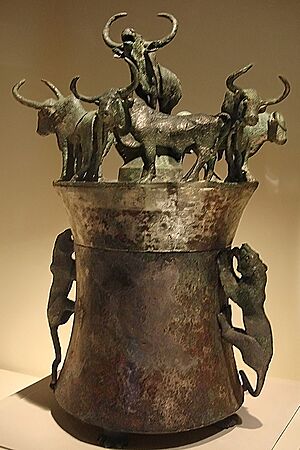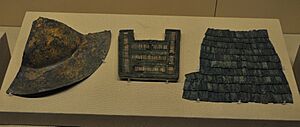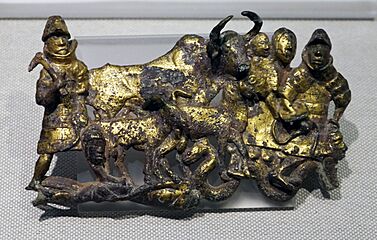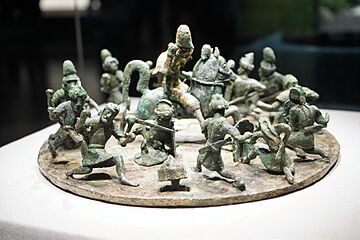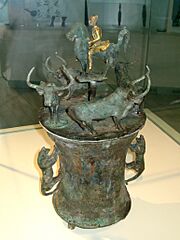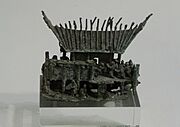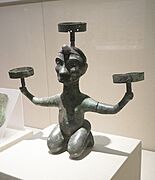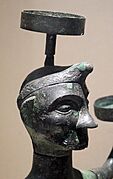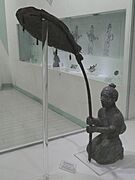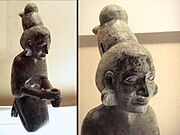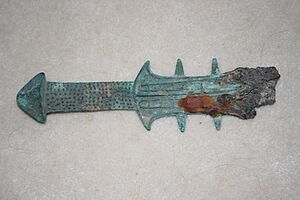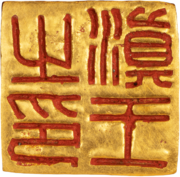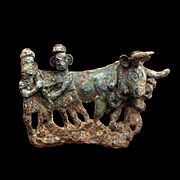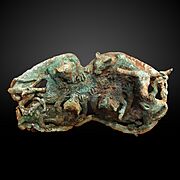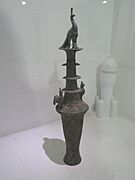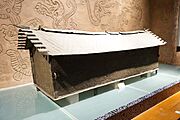Dian Kingdom facts for kids
Quick facts for kids
Dian
滇
|
|||||||
|---|---|---|---|---|---|---|---|
| 8th century BCE–109 BCE | |||||||
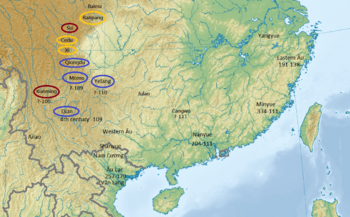
Dian and the southwestern peoples in the early Han period. Red means nomadic, yellow is semi-nomadic, and purple is sedentary.
|
|||||||
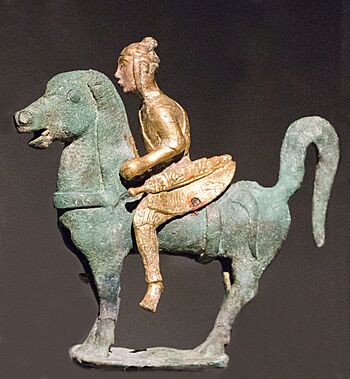
Dian Kingdom horserider, from a bronze cowry container.
|
|||||||
| Capital | Today's Jinning District 24°40′00″N 102°35′30″E / 24.666667°N 102.591667°E |
||||||
| Government | Monarchy | ||||||
| History | |||||||
|
• Established
|
8th century BCE | ||||||
|
• Annexed by the Han dynasty
|
109 BCE | ||||||
|
|||||||
| Today part of | China | ||||||
The Dian Kingdom (pronounced "Dee-an") was an ancient civilization in what is now Yunnan, China. It was located around the Dian Lake plateau. The Dian people were skilled metalworkers. They lived from around the 8th century BCE until 109 BCE.
The Dian Kingdom was known for its unique culture. They buried their dead in special pit graves. Their language was likely part of the Tibeto-Burman languages family. The powerful Han dynasty eventually took control of the Dian Kingdom in 109 BCE. This led to the Han setting up a new administrative area called Yizhou.
Contents
History of the Dian Kingdom
The Dian Kingdom was in southwestern China, near Dian Lake. A Han historian named Sima Qian wrote about its beginnings. He said it started around 279 BCE. This was when a general from the Chu state, named Zhuang Qiao, led an army to the southwest.
Zhuang Qiao reached Dian Lake during his military journey. Later, the Chu homeland was attacked by the Qin state. Because of this, Zhuang Qiao decided to stay in Yunnan. He adopted the local customs and established the Dian Kingdom. After the Qin dynasty fell, the new Han dynasty's lands bordered Dian.
Dian and Neighboring Peoples
According to ancient records, the areas southwest of the Han Empire had many different groups of people. The ruler of Yelang was very powerful. West of Yelang were the Mimo, and the Dian ruler was the strongest among them. North of Dian lived the Qiongdu people. These groups were settled farmers and lived in villages. They styled their hair in a unique, mallet-shaped way.
Other groups, like the Sui and Kunming tribes, lived further east. They braided their hair and moved around with their animals. They did not have permanent homes or rulers. Northeast of the Sui were the Xi and Zuodu tribes. Some of these groups also moved around, while others lived in fixed places.
In 135 BCE, a Han envoy named Tang Meng visited Duotong, the king of Yelang. Yelang was a neighbor of Dian. Tang Meng offered gifts and convinced the Yelang king to join the Han Empire. The Han then created a new area called Jianwei Commandery there.
Han Empire's Expansion
In 122 BCE, the Han Emperor Wu sent groups of envoys to the southwest. They were looking for a route to a place called Daxia in Central Asia. One group was welcomed by the king of Dian. However, they could not travel further. Tribes to the north and south blocked their path.
The envoys learned about another kingdom called Dianyue further west. People there rode elephants and secretly traded with merchants from the Han area of Shu.
In 111 BCE, Emperor Wu ordered the tribes in Jianwei Commandery to provide soldiers. These soldiers were needed for a war against the Nanyue kingdom. The Julan tribe feared attacks from neighbors if their men left. So, they rebelled against the Han and killed the local governor. After Nanyue was defeated, Han forces moved north. They brought many tribes, including Yelang and Julan, under their control.
Dian Kingdom Joins the Han
The Han Empire officially took over the Dian Kingdom in 109 BCE. This happened during the rule of Emperor Wu of Han. The Dian King actually welcomed the Han forces. He hoped they would help him against rival tribes. At this time, the Dian King received an official seal from the Han. This made him a tributary ruler, meaning he paid tribute to the Han.
Emperor Wu sent an official named Wang Ranyu to convince the Dian King to join. Wang Ranyu told him that many nearby tribes had already been defeated. The Dian King was at first unsure. He still had about 30,000 soldiers. He also had the support of the Laojin and Mimo tribes.
However, in 109 BCE, Han troops from Ba and Shu defeated the Laojin and Mimo. This led the Dian King to surrender. Dian became part of the Han Empire as the Yizhou Commandery. The Dian King was allowed to continue ruling for a while. However, a rebellion during the reign of Emperor Zhao of Han changed this. The Han then expanded their control. They conquered the Kunming people and reached as far as modern-day Myanmar.
Royal Burials
The Dian kings were buried at a special site called Shizhaishan. This site was discovered in 1954 in Jinning County, Yunnan. Archaeologists found a gold imperial seal there. It had an inscription that read "King Dian's Seal." This seal was given by the Han Emperor.
The historian Sima Qian wrote that the Dian were one of only two local groups to receive such a seal. The other was Yelang. Both seals have been found. The Yelang Seal was discovered in 2007.
Dian Culture
Bronze Working
The Dian people were very skilled metalworkers. They worked with both bronze and iron. They used different methods to cast bronze objects. Dian elite burials contained many impressive bronze items. Later burials also included iron objects made locally.
Large bronze drums were important to the Dian. They used them to communicate during battles. Important Dian leaders were buried with large bronze drums. These drums were often filled with cowrie shells. The tops of the drums were removed and replaced with decorative bronze lids.
Influences from Other Cultures
Some historians believe that people called Sakas might have moved to Yunnan. This happened after they were forced out of their homeland around the 2nd century BCE. Ancient Dian art shows hunting scenes that look similar to art from Central Asia. These scenes often show horsemen in Central Asian clothes.
Horsemen hunting are shown in a circular pattern on top of drums. This design is often seen in art from the Scythians, another ancient group. Scenes of big cats attacking oxen also remind us of Scythian art. These artworks show that Dian culture was influenced by other groups.
Daily Life in Dian Society
The bronze lids found in Dian burials are like windows into their world. They are covered with tiny figures and structures. These show different parts of Dian life. You can see people hunting, farming, and weaving. Other scenes show fun activities like bullfighting, dancing, and making music.
The Dian people wore tunics over short pants. They styled their hair in topknots. The bronze lids confirm what Sima Qian wrote about their hairstyles. Many scenes show the Dian people at war, often riding horses. Evidence shows that horses were used by the Dian as early as the sixth century BCE. The bronze lids also show the Dian capturing their enemies.
The Dian Kingdom was based on farming. The bronze objects also show that head hunting and slavery were part of Dian society.
Underwater Discoveries
Archaeologists recently found the remains of Dian-era buildings and pottery under Fuxian Lake. They used carbon dating to confirm their age. This shows that parts of the Dian civilization might now be underwater.
Other Interesting Artifacts
At a site called Dabona, linked to the Dian culture, archaeologists found a large double coffin burial. The outer coffin was made of wood. The inner coffin was made of bronze and shaped like a house. It weighed over 157 kilograms (about 346 pounds)!
The Yunnan Provincial Museum has many amazing artifacts from the Dian culture.
Images for kids
-
Bronze sculpture of the Dian Kingdom (felines attacking an ox).


